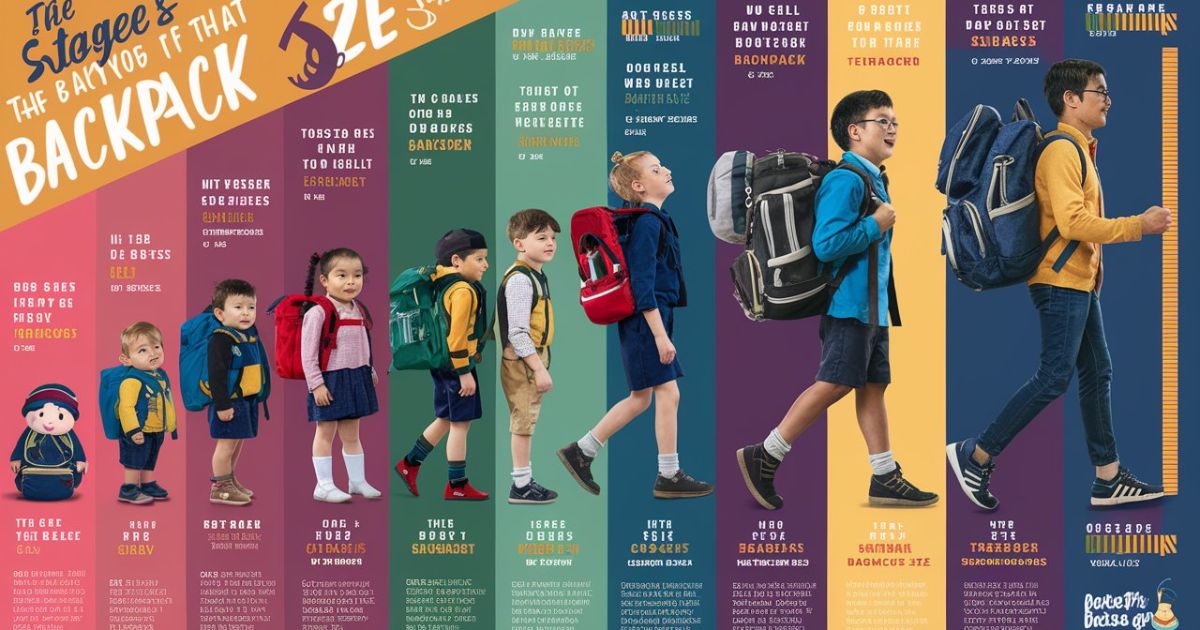Finding the perfect kids backpack size for your child is crucial for their comfort, safety, and overall well-being. An improperly fitted backpack can lead to back pain, poor posture, and even spinal issues, which can have long-lasting effects on their growing bodies.
In this comprehensive guide, we’ll explore tips, measurements, and consequences to help you select the ideal kids backpack size for your little one’s needs.

1. Tips for Kids Backpack Sizing
Selecting the right kids backpack size requires careful consideration of several factors. Here are some essential tips to keep in mind when choosing the appropriate kids backpack size:
Keep it proportional: A child’s back should never be longer than their backpack size. This simple rule ensures that the kids backpack size doesn’t hang too low, causing unnecessary strain on their back and shoulders.
Proper support matters: Position the kids backpack size between the shoulder blades for optimal weight distribution. This area provides the best support, as it’s closer to the body’s center of gravity, reducing the risk of muscle strain and fatigue when carrying the kids backpack size.
Get the measurements right: Measure the distance between your child’s shoulder blades and add 1-2 inches for the ideal kids backpack size width. For height, measure from the shoulder line to the waistline or belly button, and add 2 inches to determine the appropriate kids backpack size length. This ensures a comfortable fit without restricting movement or causing discomfort.
Ergonomic design: Look for kids backpack sizes designed to fit 4 inches below the waist and 2 inches below the shoulders. This appropriate school bag fit promotes proper posture and weight distribution, minimizing the risk of back pain and potential injuries when using the kids backpack size.
Use size charts: Consult kids pack measurements or children’s knapsack proportions charts provided by reputable brands. These charts offer age-appropriate recommendations based on average measurements, ensuring a good starting point for finding the right kids backpack size fit.
2. How to Measure a Kids Backpack?
Accurately measuring your child’s backpack is crucial for ensuring a proper kids backpack size fit. Follow these steps for precise bag dimensions guidance when determining the right kids backpack size:
Shoulder to belly button: Measure the distance from your child’s shoulders to their belly button. To determine the pack measurements reference for the ideal kids backpack size length, add 2 inches to this measurement.
Shoulder blade width: Measure the distance between your child’s shoulder blades. Their ideal rucksack sizing chart width for the kids backpack size is this measurement, plus up to 2 inches for a comfortable fit.
Size chart guidance: Refer to the knapsack proportions table provided by backpack manufacturers. These charts offer age-appropriate recommendations based on average measurements, serving as a helpful bag fit info reference when choosing the right kids backpack size.
In-store fitting: When shopping in person for the perfect kids backpack size, ensure the bottom of the backpack rests near the top of the pelvis, and the top is 2-5cm below the shoulders. This pack sizing instructions helps you visualize the perfect kids backpack size fit.
3. What Should a Kids Backpack Fit Like?
To ensure your child’s comfort and safety, it’s essential to understand what a properly fitted kids backpack size should look like. Here are some key considerations for the ideal kids backpack size fit:
Back length matters: The kids backpack size should never exceed the length of your child’s back. This bag measurement advice ensures the backpack doesn’t hang too low, causing unnecessary strain.
Measuring back length: Find the most prominent neck vertebra located approximately at the same height as the top of your child’s shoulders. Then, trace a line from the top of their hipbone around to the middle of their back. Measure the distance between these two points to determine their accurate pack proportion guidance for the right kids backpack size.
Compare measurements: Match your child’s back length (in centimeters) to the listed back length of potential backpacks. These knapsack fit instructions helps you find the perfect kids backpack size fit.
Trying on adult sizes: For older kids, consider trying on adult backpack sizes to rucksack size recommendations. Sometimes, an adult pack may provide a better fit than a designated kids’ backpack size.
Read This Blog: How To Pack A Backpack?
4. The Consequences of Using an Incorrectly Sized Kids Backpack
While it may be tempting to choose a kids backpack size based solely on its appearance or trendiness, using an improperly sized kids backpack can have serious consequences for your child’s health and well-being. Here are some potential risks to be aware of when selecting the wrong kids backpack size:
Back pain on the rise: Heavy or ill-fitting kids backpack sizes are a leading cause of back pain in children. According to a study by the American Academy of Orthopaedic Surgeons, over 14,000 children are treated for backpack-related injuries each year, often due to an improper kids backpack size.
Spine curvature distortion: Excessive force on the spine from an incorrect kids backpack size can compress intervertebral discs and strain muscles, leading to an unnatural curvature of the spine. This can have long-lasting effects on your child’s posture and overall spinal health.
Poor posture: To compensate for the weight of an improperly fitted kids backpack size, children may lean forward, rounding their shoulders and curving their upper back. This poor posture can lead to muscle strain, fatigue, and an increased risk of injury.
Increased fall risk: The imbalance caused by leaning forward to accommodate a heavy or ill-fitting kids backpack size can make children more prone to falls, potentially leading to head injuries, cracked teeth, or contusions.
5. Pack Your Kids Backpack Wisely
Even with the perfect kids backpack size, how you pack it can significantly impact your child’s comfort and safety. Follow these tips for wise packing strategies when using the right kids backpack size:
Strategic loading: Place heavier items closest to your child’s back, in the main compartment of the kids backpack size. This maximum bag load distribution technique relieves strain on their shoulders and maintains proper balance when running or playing with the kids backpack size.
Laptop/tablet sleeves: Many kids backpack sizes feature dedicated compartments or sleeves for laptops and tablets. When choosing a kids backpack size, check the dimensions of these compartments or bring your child’s device to ensure a proper fit within the kids backpack size.
Hydration on the go: Look for kids backpack sizes with external water bottle pockets or holders. Having a water bottle within easy reach encourages kids to stay hydrated throughout the day, which is essential for their health and cognitive function when carrying the kids backpack size.
Weight limit: As a general rule, a child’s kids backpack size should never exceed 10-12% of their body weight. If you notice your child struggling to carry their kids backpack size, it may be time to reassess the contents and distribute the weight more evenly within the kids backpack size.
6. Conclusion
Investing time in finding the perfect kids backpack size can prevent long-term health issues and discomfort for your child. By following the tips, measurements, and guidelines outlined in this guide, you can ensure your child carries their load safely and comfortably in the right kids backpack size, setting them up for success in school and beyond.
A well-fitted kids backpack size is not just a matter of convenience; it’s an investment in your child’s overall well-being. With the right expert bag manufacturer or skilled pack producer, you can find a kids backpack size that meets all the necessary criteria for proper fit, support, and comfort.
So, take the time to evaluate your child’s needs, consult size charts, and prioritize their comfort and safety when selecting their next kids backpack size. A little effort now can go a long way in preventing future issues and promoting a healthier, happier childhood with the perfect kids backpack size.











